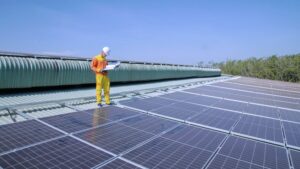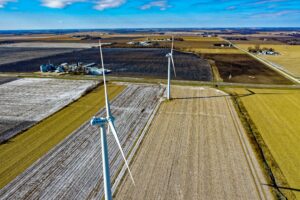Data centers are energy-intensive facilities. Furthermore, they consume a lot of electricity to power their servers, cooling systems, and more. Moreover, they contribute around 2% of the greenhouse gas emissions globally. A solution to all of these challenges is location management for data centers. It can ensure the long-term sustainability of data center operations along with minimum impact on the environment.
In this article, we will look at What are the requirements for a data center location?. So, let’s get started.
The Paramount Importance of Location Management For Data Centers
Location management for data centers is extremely vital. This is in optimizing their performance and minimizing the consumption of resources. So, a well-thought-out strategy can give great benefits including:
Minimizing Energy Costs
Data centers are known for using a lot of energy as running servers, cooling systems, and supporting equipment consume a large amount of their operating budget. Data center operators may lower their energy costs and dependency on non-renewable resources. This is by carefully placing their facilities in areas with abundant renewable energy sources. They should also look for moderate temperatures or incentives for energy efficiency projects.
Optimizing Operational Efficiency
Location is essential for optimizing operational efficiency. It reduces latency, boosts application speed, and enhances user experience. Data centers located closer to their user base can enhance customer satisfaction & responsiveness. This is by reducing network bottlenecks and minimizing data transmission costs.
Enhancing Resilience and Business Continuity
Data center operations’ resilience and business continuity can enhance by effective location management for data centers. By considering several elements including natural catastrophe risks, geopolitical stability, and regulatory settings, operators may effectively manage possible interruptions and guarantee uninterrupted service delivery, even in the case of unfavorable circumstances.
Reducing Environmental Impact
The ability to strategically manage locations may, arguably most critically, greatly lessen the environmental effect of data center operations. Data centers may reduce their carbon footprint, preserve natural resources, and help create a more sustainable future by giving preference to areas with an abundance of renewable energy sources, making use of free cooling possibilities, and putting water-efficient cooling technology into practice.
Climate and Energy Efficiency: A Delicate Balance
Finding the ideal balance between temperature and energy efficiency is essential. Since cooling and heating systems use a large amount of energy in data centers, the local environment may have a big impact on how much energy is needed for them. It includes temperature, humidity, and weather patterns.
Leveraging Free Cooling Opportunities
Places with milder weather and lower temperatures offer chances to make use of free cooling or economizer modes. These use ambient air to cool down. This strategy can significantly lessen the requirement for energy-intensive mechanical cooling systems. So, it will save a lot of money and have a less negative effect on the environment.
Addressing Extreme Weather Conditions
Regions characterized by high humidity or severe temperatures could need more powerful and energy-consuming cooling systems, which would increase their cost of operation and increase their carbon footprint. Data center managers must carefully consider the trade-offs between energy efficiency and performance under these circumstances. They must also investigate novel cooling methods and strategies. This is to mitigate the impact of inclement weather.
Monitoring and Adapting to Climate Change
As the effects of climate change grow, data center administrators must become increasingly vigilant and proactive. This is in monitoring and adapting to changing weather patterns. Over time, locations previously thought to be perfect may lose their appeal, making backup plans or relocation strategies necessary to maintain long-term viability and company continuity.
Location Management for Data Centers: Energy Sources and Sustainability
The accessibility and cost of energy sources, especially renewable energy sources, are important considerations in location management for data centers. Data centers have a voracious energy need, and if they only use energy derived from fossil fuels, they may have a significant carbon impact.
Renewable Energy Integration
Data center operators have the chance to reduce their reliance on nonrenewable sources. Moreover, they can cut down their emissions of carbon. This is by operating in areas with great amounts of renewable energy resources. It includes hydroelectric, solar, or wind power. Furthermore, with the incorporation of renewable energy, data centers can help ensure environmental sustainability and save money.
Incentives and Support Programs
Companies that engage in projects of renewable energy or energy-saving practices have the chance for subsidies and tax credits. They can also get assistance programs offered by certain locations. The use of server virtualization, more effective cooling systems, or sophisticated monitoring and control systems might also be encouraged by these programs.
Exploring Innovative Energy Solutions
Data center operators should be willing to investigate cutting-edge energy solutions that can improve sustainability and lessen their environmental effects as long as technology is still developing. These might include energy storage devices, microgrids, on-site energy production, and even cutting-edge technologies like nuclear fusion and hydrogen fuel cells.
Location Management for Data Centers: Proximity to End-Users and Network Infrastructure
Location management for data centers must take into account not just sustainability and energy efficiency. They should also see accessibility to end users and the presence of a strong network infrastructure. Data centers situated in closer proximity to their intended user base have the potential to increase customer happiness and loyalty. This lowers latency, optimizes application performance, and improves the overall user experience.
Edge Computing and Distributed Data Centers
The significance of dispersed data centers has been underscored by the emergence of edge computing and IoT. Businesses may minimize network bottlenecks, lower data transmission costs, and enhance overall system responsiveness. This is by strategically placing facilities closer to the edge, where data is created and consumed. By reducing long-distance data transmission requirements and minimizing network-related energy consumption, this dispersed strategy can improve performance while potentially supporting energy efficiency.
Connectivity and Network Infrastructure
It’s critical to take network infrastructure quality and availability into account while assessing possible sites. Reliable, fast, and redundant network connections are necessary. It guarantees uninterrupted data delivery and reduces downtime. Moreover, robust network infrastructure locations can offer the connection and redundancy required for mission-critical data center operations. Such infrastructure includes fiber optic cables, internet exchange points, and numerous telecommunications providers.
Balancing Performance and Efficiency
Data center operators must carefully balance the performance benefits of being close to end users. It should be with the objectives of energy efficiency and sustainability. There are situations when closeness may not always be as important as regions with a wealth of renewable energy sources or ideal climates. As a result, it can make a trade-off study necessary to decide on the best site plan.
Location Management for Data Centers: Geopolitical and Environmental Considerations
Location management for data centers must take into account environmental and geopolitical issues. These elements influence the facility’s resilience and long-term survival.
Political Stability and Regulatory Environment
The operational risks and expenses related to data center operations can be greatly impacted. This is to the political stability and regulatory climate of a possible site. Data center operators may find a more predictable and business-friendly climate in areas with stable governments, advantageous tax laws, and explicit laws. It should be about data protection, cybersecurity, and environmental compliance.
Natural Disaster Risks and Mitigation Strategies
The possibility of natural catastrophes, such as earthquakes, floods, storms, or wildfires, is another important factor. Data centers are essential pieces of infrastructure. So, even little interruptions in their operations may have a serious negative impact. This is on the companies and services that depend on them. Data center operators should carefully consider the risks that might arise from natural disasters when choosing a site. They should then put in place the necessary mitigation measures. It includes redundant power and cooling systems, sturdy physical infrastructure, and thorough disaster recovery plans.
Water Availability and Management
Water management and availability should also be taken into consideration. Areas with few water resources or subpar water management techniques may make long-term operations difficult. This is for cooling data centers due to the significant volumes of water needed. Data center operators may reduce water-related hazards and support responsible resource management. This is by choosing sites with an abundance of water resources and using water-efficient cooling technologies. It includes air-side economizers or liquid cooling systems. So, these are what make a good data center location.
To Sum Up
To manage the site of data centers effectively, one must carefully take into account several elements. These elements were discussed in the article and will help you in effective management. Data center operators may optimize their facilities for long-term durability, performance, sustainability, and energy efficiency by carefully assessing these components.
The need for competent location management for data centers will only rise. This is in tandem with the ongoing need for data centers. Data center operators may optimize their settings to minimize environmental concerns. They can then also take advantage of free cooling possibilities and prioritize renewable energy sources. This will not only save operating costs but also help to create a more sustainable future for the sector.
Additionally, going to events like the Energy Efficiency For Data Centers Summit, which is scheduled for May 16–17, 2024, in Dallas TX, USA may offer insightful talks and networking opportunities that will help you remain on top of best practices for data centers. Leaders, experts, and innovators in the field will gather for this two-day conference to discuss state-of-the-art approaches to lowering data center energy consumption, optimizing cooling systems, embracing automation and artificial intelligence-enabled data centers, and more. Register today!





